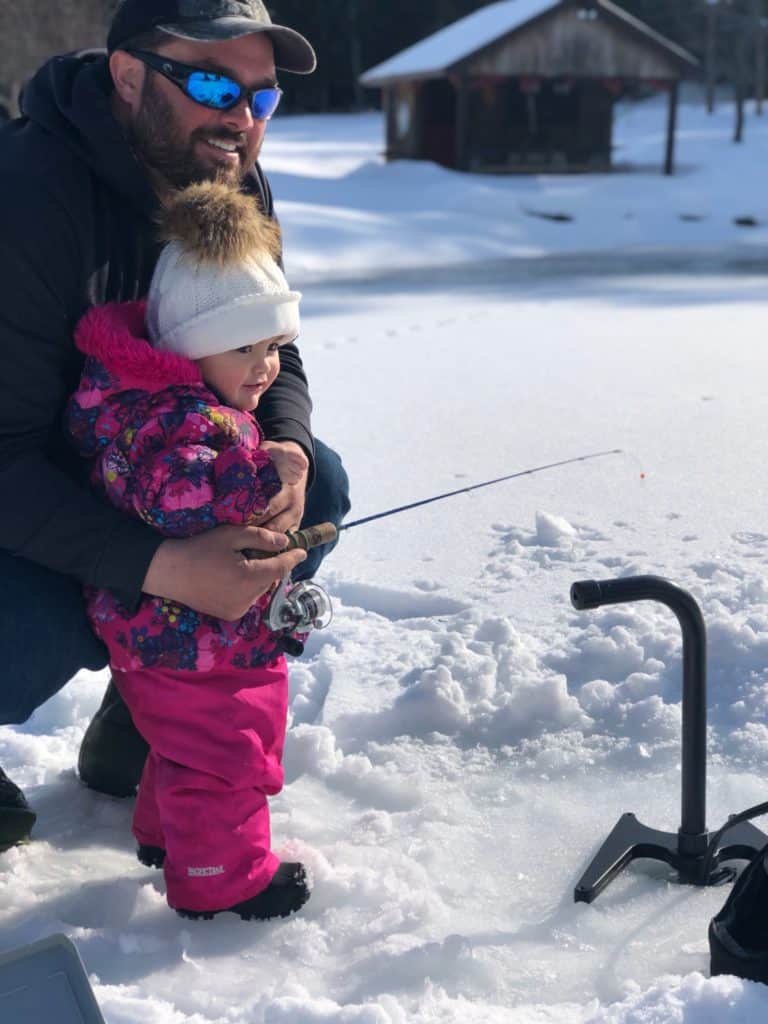
How to enjoy yourself and stay safe on the ice this winter
As winter sets in, many Vermonters are preparing for one of the most popular cold weather pastimes in the state – ice fishing. Anglers spend more than 400,000 days each winter ice fishing in Vermont, and the state’s Fish & Wildlife Dept. is encouraging more people to give it a try.
Department fisheries biologist Shawn Good said ice fishing is a fun, social, family-oriented activity, and that there are many great reasons for Vermonters new to the sport to try it this year.
“Ice fishing is generally more accessible than open water fishing,” says Good. “Almost anyone can walk out on a frozen lake or pond and fish through the ice. And once you’re out there, there’s lots of room to spread out.”
Ice fishing can be more sociable than open water fishing, with friends and family gathering on the ice for cookouts and winter fun, along with the fishing.
“For many, it’s not just about the fish. Kids love ice fishing because they can run around and slide on the ice or play in the snow. I’ve seen families with grills, food and hot drinks having a great time. They set their tip-ups, build snowmen, play football, and even skate in between bouts of fishing.”
It’s inexpensive and simple to get started. “An auger used for cutting holes in the ice is the most expensive piece of equipment you’ll need. But you can get a 4-inch or 6-inch hand auger for under $50 and share it with others, so not everyone needs one. Add a scoop for cleaning out the holes and an ice fishing rod and reel combo or a couple tip-ups with hooks, weights and bait and you’re set for a fun day on the ice.”
When you’ve had a successful outing, bringing home a meal of healthy, locally caught fresh fish is a delicious benefit.
“I think fish taste better in the winter,” said Good. “There’s something different about pulling a tasty perch, bluegill or bass from ice cold water. They tend to be firmer and have a milder taste than in the summer.”
Good says it is normal for new anglers to worry about venturing out on frozen water, but with a few basic precautions and common sense, ice fishing is safe.
“A minimum of 3 to 4inches of clear black ice is safe to walk on. If you’re unsure about ice thickness in your area call your local bait and tackle shop. They’re always up on current conditions and can help you get started with gear and advice, too. You can also look for other people out fishing. Experienced anglers know how to read the ice, so if you’re unsure, go where others are or have been,” advised Good.
Good says that with the mild winter so far this year, most anglers are finding that ice fishing opportunities have been restricted primarily to Vermont’s smaller ponds or higher elevation areas that have formed good ice.
“Many large lakes still have not developed thick, solid black ice. Some haven’t frozen over at all yet. Anglers looking to get out should focus on smaller waters and make the effort to check ice thickness frequently as you venture across the ice.”
It is important to know that ice isn’t always uniform in thickness. Areas around pressure cracks or near stream or river inlets can be thinner and weaker than surrounding ice. Good advises anglers to carry a set of ice picks, head out with a partner, and let someone know where you will be fishing, your access point and when you plan on returning home.
Good says dressing properly is key. “On a calm sunny day, you’ll be surprised how comfortable you feel. Even with the thermometer showing single digits, the sun will warm you right up. Make sure you dress in layers and keep your head, hands and feet covered and dry, and you’ll be quite toasty,” said Good.
No matter where you are in Vermont, an ice fishing opportunity is close by. Ice fishing is a great way to enjoy the outdoors in winter, offering a fun, unique winter experience.
To learn more about ice fishing for beginners, visit Vermont Fish & Wildlife’s “Ice Fishing Basics” webpage: vtfishandwildlife.com/fish/fishing-opportunities.vermonts-ice-fishing-opportunities/ice-fishing-basics.




